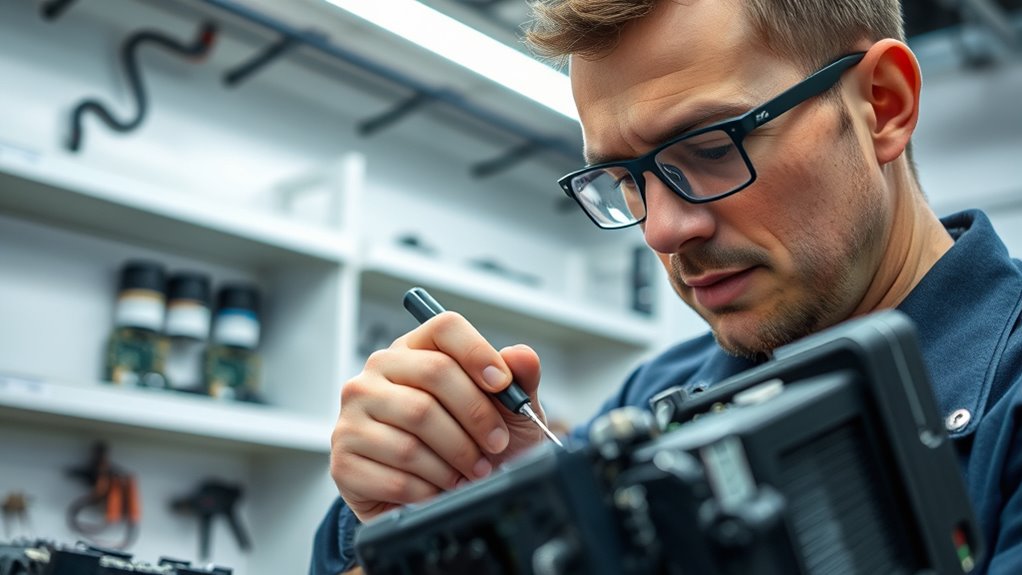When choosing reconditioning service providers, prioritize reliability by reviewing their quality assurance practices, such as detailed testing, transparent inspections, and industry-standard procedures. Check customer testimonials to see how consistent their promises are and look for warranties that show confidence in their work. A provider offering clear warranties and proven quality measures indicates trustworthiness. If you want to understand exactly what to look for, there’s more to uncover that can help you make the best decision.
Key Takeaways
- Review provider’s detailed documentation and testing protocols to ensure adherence to industry standards.
- Evaluate customer testimonials for consistency in quality, communication, and overall satisfaction.
- Confirm the presence of comprehensive warranties covering repairs and replacements post-reconditioning.
- Inquire about the provider’s quality assurance procedures and how they extend equipment lifespan.
- Choose providers with transparent processes and positive reputations for reliable performance and support.

Ever wondered how used equipment gets a new lease on life? It’s all thanks to dedicated reconditioning service providers who specialize in restoring and upgrading machinery to meet top standards. When you’re considering working with one, evaluating their reliability is vital. You want to know that their process guarantees quality assurance, ensuring the equipment performs like new or better. Reconditioning isn’t just about cleaning or fixing; it involves thorough testing, parts replacement, and meticulous inspections. Reputable providers often showcase their commitment to quality assurance through detailed documentation and rigorous testing protocols. These steps give you confidence that the equipment will operate efficiently, reducing downtime and maintenance costs down the line. Understanding the history of pinball machines can also provide context for the durability and design standards that reconditioning services aim to restore.
Reconditioning ensures equipment reliability through rigorous testing, documentation, and quality assurance, extending lifespan and boosting operational efficiency.
Customer testimonials can be invaluable when gauging a reconditioning service provider. Hearing directly from other clients helps you assess the provider’s reliability and the quality of their work. Positive testimonials often highlight how the provider stood behind their work with warranties, quick turnaround times, and transparent communication. Such feedback reassures you that the provider isn’t just making promises but consistently delivering on them. Conversely, if you come across testimonials citing delays, hidden costs, or equipment failures post-reconditioning, it’s a red flag. Always look for reviews that detail the provider’s commitment to quality assurance and customer satisfaction, as these reflect their dedication to excellence.
When you’re choosing a reconditioning service, don’t shy away from asking about warranties. A reliable provider stands by their work, offering warranties that cover repairs or replacements if issues arise shortly after reconditioning. Warranties are a sign of confidence in their process and a safeguard for your investment. It’s also wise to inquire about their quality assurance procedures—do they follow industry standards? Do they conduct thorough testing? A trustworthy provider will be transparent about their methods, which helps you make an informed decision.
In the end, choosing a reconditioning service provider isn’t just about price; it’s about trust, quality, and peace of mind. By paying close attention to their quality assurance practices and customer testimonials, you’re better positioned to select a partner who will deliver equipment that performs reliably and comes with the support you need. Remember, investing in reputable reconditioning means you’re not only extending the lifespan of your equipment but also ensuring your operations stay efficient and productive.
Frequently Asked Questions
How Do I Verify a Reconditioning Provider’s Certification?
You verify a reconditioning provider’s certification by checking their adherence to industry certification standards and reviewing their credentials. Ask for proof of certification from recognized organizations and confirm their credentials align with established standards. Research their reputation through reviews or industry references. Confirm that their certification is current and valid, and don’t hesitate to contact certifying bodies for verification. This helps ensure you work with a trustworthy, qualified provider.
What Are Typical Warranty Durations Offered by Providers?
Typically, providers offer warranty coverage ranging from 6 months to a year, depending on the service quality and provider reputation. You should look for extensive warranties that cover parts and labor, giving you peace of mind. A reputable provider tends to offer longer warranties, reflecting confidence in their work. Always review warranty terms carefully to ensure they meet your needs and confirm the provider’s reputation for honorably fulfilling warranty commitments.
Can I Get a Sample Reconditioning Report Beforehand?
It’s quite common to request a sample reconditioning report before committing, especially when you consider the coincidence of a provider offering transparency. You can usually obtain a preliminary inspection report, which highlights the scope of work and condition details. This helps you gauge the provider’s transparency and reliability, ensuring you’re comfortable with their process before proceeding. Always ask upfront; reputable providers often accommodate such requests to build trust.
How Do Providers Handle Parts Replacement During Reconditioning?
You should ask providers about their parts replacement procedures and how they manage their parts inventory. Reliable providers typically use documented procedures, ensuring quality and consistency during replacements. They maintain a well-organized parts inventory to quickly access necessary components, reducing delays. This process often involves thorough inspection and approval steps, so you can trust that parts are replaced properly and efficiently, meeting quality standards and preserving the reconditioned item’s value.
What Are the Common Reasons for Warranty Rejection?
You might wonder why your warranty gets rejected, and it often comes down to the warranty policy and service quality. Common reasons include improper handling of parts, unauthorized repairs, or neglecting recommended maintenance. When providers overlook these details, they risk voiding your warranty. Pay close attention to the fine print, insist on quality service, and guarantee all procedures align with the warranty policy to avoid surprises and maximize your coverage.
Conclusion
Choosing a reliable reconditioning service provider is like selecting a steady compass in a storm—your trust guides the way. Their warranty acts as a lighthouse, illuminating your path and offering reassurance amid uncertainty. When you assess their reliability, you’re planting a seed of confidence that grows into a sturdy tree, providing shelter and stability. Ultimately, your decision becomes the anchor that keeps your equipment, and your peace of mind, firmly grounded.










